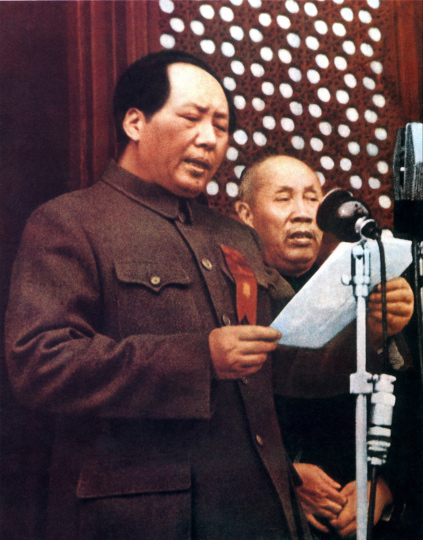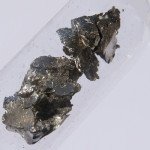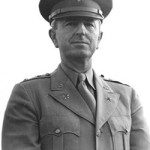Modern Chinese History VI: Creating a Communist Mindset 1949-1957
Introduction

Mao proclaiming the Founding of the PRC
On October 1, 1949, Mao Zedong declared the founding of the People’s Republic of China (PRC) stating, “China has stood up!” The PRC was recognized by the Soviet Union on October 2nd and by other Communist countries shortly thereafter. The PRC was also recognized by India, Burma, Pakistan, Ceylon, Britain and France, but not recognized by the United States until January 1979. Instead, during the 1950s, 60s and 70s, the US considered that the Taiwanese government – led by Chiang Kai-shek and members of the Guomindang (KMT) which had retreated to Taiwan after it had lost the Chinese Civil War – to be China’s legitimate government.
To stand up to the world was no easy task for China in 1949. The China that Mao inherited lay largely in ruins. Industrial production was 44% below what it had been in 1937. Agricultural output hovered at subsistence level with many Chinese citizens facing starvation. Inflation was rampant. Much of the railway and transport networks had been damaged or destroyed during the fighting. Many industrial and other professionals fled with the KMT. These professionals took with them physical, financial and intellectual assets as well as a significant collection of art. Additionally, China’s military capacity was weak, outmatched by rival powers.

Much of China was in Ruins after the Civil War
The Chinese Communist Party (CCP) party was not well prepared to deal with these challenges. To begin with, the CCP had only 4.3 million members in 1949 – less than 1% of the total population- leaving it with a shortage of reliable officials that could take over the reins of government. A recruitment drive was launched to compensate, and CCP membership grew by 3 million people between 1949 and 1952, but many of these new recruits lacked experience in the responsibilities they were asked to take on. Additionally, the CCP had operated outside of urban environments during most of its existence. Now it planned to make the industrial proletariat the center of its new social order, despite the proletariat consisting of only 5% of China’s 600 million citizens. The peasants – who were at the heart of the CCP’s power base and had been central to the CCP winning the Civil War – were now given a subsidiary role in new China. It was to be the peasants’ job to feed China’s industrial workers and to create grain surpluses that could be used to pay for machinery imported from the Soviet Union.
These challenges notwithstanding, great strides were made on many fronts in the early years of the PRC. The CCP stabilized China’s economy, controlled inflation and re-ignited economic growth. Basic hygiene policies reduced the mortality rate. Land and marriage reform improved the quality of life for millions of Chinese citizens. The last vestiges of foreign imperialism were eradicated. China reasserted political control over Inner Mongolia and Xinjiang which had been enjoying greater independence during China’s decades of war. The PRC also successfully invaded and also re-absorbed Tibet. The PRC fought the US and UN troops to a standstill during the Korean War, greatly increasing China’s prestige abroad and his authority domestically.
Political Organization
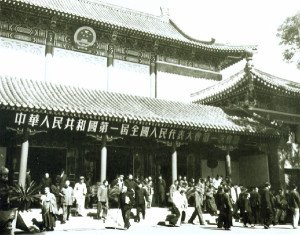
The First People’s Congress 1954
As the CCP took political control of country in 1949, it initially worked to gain allegiance from non-communists political, religious and intellectual leaders who were not directly affiliated with the defeated KMT. To this effect, Mao organized the Chinese People’s Political Consultant Conference (CPPCC) which included CCP as well as non-Communist minority parties, members of the People’s Liberation Army (PLA), ethnic minorities and overseas Chinese. The CPPCC passed the Organic Law and the Common Program. The Organic Law became the temporary constitutional basis for the new government. The Common Program made clear many of the policies that the CCP intended to implement. One such policy established equal rights for women, including the freedom to divorce and to choose whom they married.
Mao Zedong was elected chairman of the provisional government and remained as Chairman of the CCP. All important leadership positions in the new regime were given to CCP members, although lesser positions were bestowed on minority party members who had been supportive of the CCP during the Civil War. The government’s political and economic framework reflected the principles that Mao Zedong championed in his New Democracy writings in which he laid out that new China would be built on a Marxist societal structure and economy. Going forward, China’s economy would be led by a state-owned industrial sector supported by collectivized agriculture and a smaller private sector.
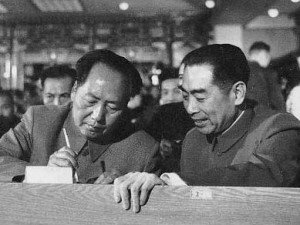
Mao and Zho Enlai at the 1954 National People’s Congress
By 1954, the provisional government had been formalized, and the Constitution was approved by the first National People’s Congress. The Constitution tightened the CCP’s hold on power by stating in Article I that the PRC would be led by the CCP and not by a coalition government as had been suggested during the CPPCC. The new government was to be led by the National People’s Congress (NPC) whose communist delegates would come from each of China’s provinces, autonomous regions, and independent municipalities. It was the NPC’s job to enact legislation, rule on economic plans and amend the Constitution. When the NPC was not in session, the government’s Standing Committee exercised the NPC’s functions. Underneath the NPC was the State Council to which reported China’s various ministries, including the army which was placed under the newly formed Ministry of Defense. Regional People’s Congresses were also created at the provincial and local levels. Although the 1954 Constitution made reference to elections, in fact, the CCP nominated all candidates. It was expected that those elected would strictly follow CCP policies.
Stabilizing Inflation and the Economy

Chinese Workers rebuilding a rail line in 1950
At the same time as it was creating a governing political structure, the CCP was also working to stabilize the economy. A first task was to bring inflation under control. To do this, the CCP created a people’s currency – the renminbi (literally “people’s currency”)– which replaced the KMT’s yuan. Only a short time was allowed for the yuan to be exchanged for the renminbi. Thereafter, any exchange in gold, silver or foreign currency was prohibited. The CCP kept firm control of the bank notes in circulation. It also guaranteed that savings and wages were tied to a basket of goods including food staples, cloth, coal, and cooking oils, thus guaranteeing the purchasing power of wages regardless of their monetary value. These policies succeeded in reducing annual inflation to 2% or below between 1952 and 1957.
The CCP also went to a long way to balancing the budget by raising taxes on urban dwellers and by aggressively cutting government and military spending. It invested little, for instance, in public health. Health spending never increased above 2.6% of the state budget through 1956. That said, vaccination campaigns and the implementation of basic hygiene, disease and pest control measures led to a real drop in China’s mortality rate. From 1950 onward, China’s population began to expand rapidly. Mao encouraged this population growth as he felt that a large population was a competitive advantage.
Initially at least, the CCP’s first rule in solidifying industrial production was to do no harm. It allowed private urban industry to continue and the CCP worked hard to stop factory closures, to prevent production disruptions due to shortages, and to keep urban unemployment from rising. Workers were told not to strike regardless of their complaints.
Creating a Communist Mindset
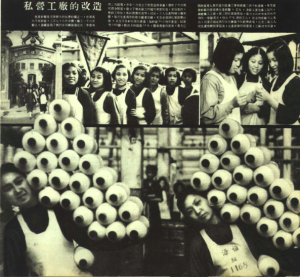
Chinese Communist Propaganda Poster
Integral to creating a new political framework and righting the economy was the implementation of Communism in China. For Mao, China’s Communism was to be more than just a new political, economic and social structure. Mao also wanted to change Chinese thinking so that the masses were engaged not just with their actions but also with their hearts and thoughts. Mao’s idea was to initiate campaigns to expose those who were not fully behind the Communist movement. Those so exposed could then be won over or neutralized. The mass quality of the campaigns had the effect of making everyone complicit in the Party’s actions, especially when the actions led to execution, humiliation and torture. Mao believed that the blood of the revolution should drip from everyone’s hands.
To effectively execute these campaigns, the CCP created a complete monopoly over all communication outlets. It also began to organize China’s entire population into various mass organizations over which the government could then exercise control. Examples of mass organizations established by 1953 included the 18 million members All China Federation of Democratic Youth, the 76 million member All China Democratic Women’s Federation, and the 20 million member Young Pioneers. Eventually, urban workers were collected into danwei (working units) which provided housing, shops, schools and recreational facilities in self-contained communities, and peasants were brought together in large collectives.
Once within these organizations, Chinese citizens were encouraged to attend regular political meetings and to study communist teachings. The teaching stressed the need for loyalty to the Communist Revolution over loyalty to family and friends. Citizens were encouraged to report individuals who were not good communists. Struggle sessions were then held against them.
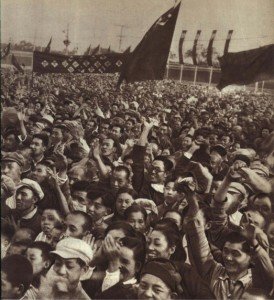
Mass Political Rallies were mandatory
For more recalcitrant cases, reluctant communists often underwent an indoctrination process that could last up to a year. Usually, indoctrination started with individuals being removed from their friends and family and being cut off from contact with the outside world. Recalcitrant citizens were split into small groups and lodged in often ramshackle conditions. For the first few months recalcitrants were worked long hours so that fatigue could help fracture their resistance. Thus depleted, recalcitrants were then forced to criticize themselves and each other’s backgrounds. After a while, the hours of hard labor were reduced, food improved and criticism sessions were lengthened to include the study of Marx, Lenin, Stalin and Mao. The study sessions emphasized the superiority of communism while depicting China’s imperialist and republican pasts as dark, backward, unjust and corrupt. It was expected that, during this second phase, individuals would undergo an emotional breakdown during which they came to see that opposing the CCP was futile. Instead, once they began to fully accept CCP teachings they usually experienced real emotional relief. Solidifying their acceptance of CCP teachings usually lasted an additional 3 to 4 months during which time they often saw new truths in communist theory. Part of this consolidation process involved their aiding others to find the true communist light. Once returned to their political and societal organizations, their new communist thinking was continually underpinned by study sessions and political rallies.
Mass Campaigns
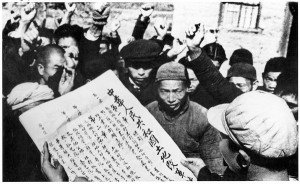
Reading out the Land Reform Law
Mao’s remolding of the individual was a precursor to his remolding society. Mass campaigns were a key tool by which he sculpted new China. As it still does today, the CCP often tested its social campaigns regionally before expanding them nationwide. Often quotas were set as to the number of people that would need to be reformed or eliminated. Most of these quotas were arbitrarily established.
The CCP’s earliest social campaigns were focused on consolidating CCP control by eliminating pockets of opposition and by strengthening its rural base. For instance, between 1950 and 1951, Mao called on CCP faithful to eliminate “bandits, spies, bullies and despots as well as KMT agents and saboteurs”. His call resulted in an estimated 2.6 million real and perceived enemies being executed.
In 1950, the CCP passed the Agrarian Reform Law which ultimately resulted in an estimated 200 million acres of arable land being redistributed to an estimated 75 million families. During land reform, the holdings of landlords were reallocated while the farms of rich peasants were often left intact as they frequently grew a large percentage of an area’s food. The factors which classified peasants into different classes was multifaceted, yet the ultimate classifications were consequential. A family’s class label not only decided how much land it would gain or lose, but its class label also had an impact on its work and marriage prospects going forward. Children inherited their social class from their parents. If a divested landlord son married the daughter of a poor peasant, for instance, their children would still be considered landlords regardless of their poverty.
Land Reform was administered at the county level and was managed by work teams of 3 to 30 people. The work teams set up local peasant associations to identify those who had engaged in harsh and exploitative practices. Important goals of these early meetings were to overcome the deference with which peasants traditionally treated rural gentry and to destroy the power base of the landlord elite. “Speak bitterness” campaigns were used to empower peasants and to make all complicit. During the struggle meetings, landlords were publicly criticized, accused, humiliated, beaten and even executed. It is estimated that 1 million landlords were killed during this period.
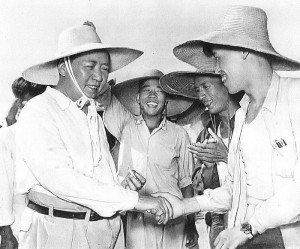
Mao with People’s Commune Workers
The ‘Campaign to Suppress Counterrevolutionaries and to Resist America and Aid Korea’ was also launched during this time. By late 1950, China had entered the Korean War against the Americans and the United Nations. The Suppress Counterrevolutionaries and Aid Korea campaigns were to support China’s war effort by eliminating domestic spies and enemy agents – real or alleged. Anyone that could be shown to have previous links with the KMT were especially targeted as were those who had any connection with foreign firms, universities and churches. Foreign business assets were frozen and foreigners were compelled to sell their companies to the CCP at below market prices. Afterwards, foreigners were largely cleared from China.
As the Suppress Counter-Revolutionary Campaign progressed, it grew in violence and in the ways that humiliation tactics were employed. While some accused counterrevolutionaries were prosecuted through the Chinese judicial system, the large majority were indicted in mass meetings that ultimately engaged an estimated 80% of the Chinese population. Factories, schools, government offices and street organizations were encouraged to root out state enemies. It is believed that over 500,000 people were executed during this effort.
The 1951 Three-Antis Campaign was a mass movement against corruption, waste and bureaucracy. The CCP gave word that about 25% of all Party members would be purged as a result of the mass investigations. The denounced were not allowed to defend themselves; they could only confess their wrongdoings. This stage-managed quality of these meetings became increasingly common feature of mass investigations. The Three-Antis Movement helped the CCP to consolidate its control over labor by getting workers to side with the CCP against their bosses. Usually the more senior CCP officials were the ones indicted for corruption.
Overlapping with the Three-Antis Campaign was the CCP’s 1952 Five-Antis Campaign meant to stamp out bribery, tax evasion, fraud, the theft of government property and the sale of state secrets. This campaign largely targeted wealthy industrialists and merchants. Having stabilized China’s economy, the CCP felt that it could now take action to reduce the size and wealth of China’s private businesses. It also wanted to erode the power base of the national bourgeoisie. Worker’s organizations were encouraged to inspect the finances of their employers in order to identify tax evasion, fraud, bribery and other financial abuses. Leaders of the worker’s organizations could then be rewarded by being able to take over the positions of the managers that they denounced. At the same time, the CCP would install party officials within the larger businesses. CCP officials would then oversee operations and collect information for the state. After the Three-Antis and the Five-Antis Campaigns, worker-employer meetings became a staple part of most businesses, and workers were encouraged to report on both their employers and co-workers if they were acting in breach of communist policies.
The First Five Year Plan
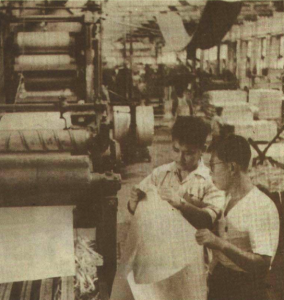
Tianjin Papermaking Plant 1952
As the CCP consolidated its control over both society and the economy, it began to think about developing its first five year plan. China’s first five year plan copied the five year plans of the Soviet Union with their focus on heavy industry, high rates of savings and investments and collectivized agriculture. It was expected that, as China’s economy became progressively centralized, the five year plans would grow to determine all aspects of economic activity including the production of capital, consumer and agricultural goods, the development of transportation and communications networks, and the creation of health, education and welfare infrastructure. China’s first five year plan covered the years from 1953 to 1957. It set as a target the construction of 694 industrial projects, 156 of which were to be built with Soviet aid. 58.2% of its capital outlay was slated for industrial construction, 19.2% for transportation, posts and telecommunications, 7.6% for agriculture, forestry and water conservation, and 7.2% percent for cultural, education and public health.
The CCP helped finance the plan by procuring agricultural surpluses cheaply and by keeping grain prices low. Establishing state agricultural quotas gave the CCP grain to export to the Soviet Union to pay for loans, technical assistance and heavy equipment. During this period, more than 10,000 Soviet engineers, technicians, and scientists assisted in developing and installing new heavy industrial facilities, including entire plants and pieces of equipment purchased from the Soviet Union. An even greater number of Chinese students and engineers traveled to the Soviet Union and Eastern Europe countries for education and training.
During the First Five Year Plan, private industry in China was all but eliminated. By 1956 about 67.5% of all major private industrial firms were state owned, and 32.5% were under joint public-private ownership.
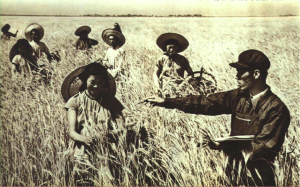
Henan Wheat Harvest 1952
Agriculture also underwent extensive organizational changes despite any significant state investment in the industry. Instead, its 4% annual growth rate resulted primarily from gains in efficiency brought about by land reform and the establishment of cooperative farming. From 1953 onward, the government encouraged peasants to voluntarily pool their farms. These small cooperatives resulted in higher yields which in turn provided the peasants with extra resources which they then used to raise and sell livestock. Small farming markets began springing up across the nation. Unlike the large scale collective farming policies which were launched in 1958, these early cooperatives were successful and popular. By 1957, about 93.5% of all farm households had joined producers’ cooperatives.
Urban workers also benefited from China’s early economic progress. The urban proletariat saw improvements both in living standards and job security. That said, urban workers had little choice in the job that they performed and were given little personal mobility. Increasingly, all Chinese were registered by area. Travel became strictly controlled, especially that of peasants wishing to come to the cities.
In terms of economic growth, the first five year plan exceeded most of its targets. Iron and steel manufacturing, coal mining, cement production, electricity generation, and machine building industries all grew significantly, and were put on a more modern technological footing. Overall, industrial production rose at an average annual rate of 19% between 1952 and 1957 while national income increased 9% a year.
China’s Foreign Policy

Mao and Stalin
As the PRC was implementing its political and economic policies, he was also crafting his foreign policy positions. Early foreign policy objectives included eradicating remaining foreign imperialism in China, ensuring that no country violated China’s borders in the future, and returning China to a position of international prominence. Mao also wished to promote communist revolution abroad.
Marxist ideology played a real role in crafting China’s foreign policy positions. Mao was impressed with the Soviet Union’s rapid industrialization despite its human costs. The CCP believed that if Marxist economic principles were applied faithfully, then China too would see rapid development. Because of this and because of his distrust of the West, from the first days of the PRC, Mao made it clear that the PRC would “lean to one side”, meaning that Mao intended to reject aid from capitalists such as America and Britain and to align itself with the USSR and other communist countries. Mao believed their common ideologies would create strong bonds. He also believed that aligning with Soviet countries would underpin the momentum of the Chinese communist revolution domestically.
Having made the decision to align itself with the USSR, Mao further stated that he would “clean the house before inviting in the guests” meaning that he would not recognize diplomatic relations, treaties or agreements which the PRC had inherited from the Republic of China and that he would clean the country of any remaining colonial influences. All new diplomatic relations and treaties China entered into were to be based on equality, and were to be negotiated on a country by country basis. Additionally, The PRC would not establish diplomatic relations with any country that continued relations with the KMT.
Yet while Mao leaned toward Moscow, the USSR had proven to be an inconsistent ally. At the end of the second 1937-1945 Sino-Japanese war, for instance, the USSR agreed to cooperate with and recognize Chiang Kai-shek’s KMT government despite the growing strength of the Chinese communists. At the 1945 Yalta conference, the Soviet Union had insisted on retaining its economic, port and railroad rights in Manchuria and in the Sakhalin and Kurile Islands which China also claimed. Thus, Mao’s house cleaning also needed to include the USSR. Additionally, Stalin assumed that the Soviets would continue to lead the Communist world, a stance inconsistent with Mao’s long-term desire to return China to a leadership position in the international arena.
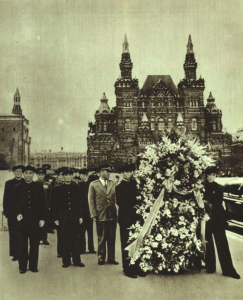
1952 Chinese Mission to Moscow
The challenges of the Sino-Soviet relationship were made clear when Mao traveled to Moscow to meet with “big brother Stalin” for the first time in December 1949. Initial talks between Mao and Stalin accomplished nothing, and Stalin treated Mao in a way that made him feel personally slighted. It wasn’t until February 1950 that Mao and his chief diplomat Zhou Enlai finally succeeded in getting the Soviets to sign the Sino-Soviet Treaty of Friendship, Alliance and Mutual Assistance. The treaty set out that the two countries would assist each other in the case of renewed Japanese or Allied aggression. In separate treaties, the Soviet Union agreed to withdraw its troops from Manchuria and to return the Manchurian Railway and other property in Dalian and Lushan, thus effectively abrogating the special privileges in Manchuria that it has secured from the KMT at the end of the war. China in turn recognized the independence of Outer Mongolia. The USSR also agreed to give the PRC a loan of $300 million and to provide it with technical and economic assistance which the loan itself financed.
Having recovered complete Chinese sovereignty in Manchuria, Mao turned his attention to Xinjiang, Inner Mongolia, Hong Kong, Tibet and Taiwan. Mao was intent upon restoring China’s borders to those established at its maximum historic extent during its imperialist era. In terms of Xinjiang and Inner Mongolia, the PRC moved quickly to re-establish a firm political and military grip on the provinces and began to encourage the migration of Han Chinese into the areas. In terms of Hong Kong, Mao decided not to demand Hong Kong’s immediate return. As a British protectorate, Mao believed that Hong Kong would be useful both as a base from which the PRC could collect international intelligence and as a port from which the PRC China could import international goods and capital.
Invasion of Tibet

PLA Marching into Lhasa 1950
Tibet was given no such clemency. Mao never considered that the pseudo-independence which Tibet enjoyed during the second Sino-Japanese War and China’s Civil War to have been legitimate, despite declaring during the war with Japan that minorities would be free to decide their own destinies once the war had been won. Instead, Mao argued that the CCP had what amounted to a moral duty to free Tibet from it semi-feudal, backward, theocratic state. Consequently, in October 1950, China invaded Tibet. Tibet tried to secure international assistance for it defense saying – “Liberation from what and from whom? We are a happy country.” – but no significant help was forthcoming. By May 23, 1951, Tibetans had little option but to sign in Beijing the 17 Point Agreement for the Peaceful Liberation of Tibet. The Agreement left Tibet’s political, economic and social systems in place with the Dalai Lama at its head while Tibet in turn agreed to recognize China’s sovereignty over Tibetan territory.
Taiwan 1950

Taipei 1951
Having re-secured Tibet, Mao’s next objective was to regain control over Taiwan. In a January 1950 speech Truman stated that America would take a neutral stance towards Taiwan and stop military assistance to Chiang Kai-shek’s KMT regime. Mao interpreted that speech as giving it a clear hand to retake the island. Mao and his generals knew that retaking Taiwan would be difficult. Not only was Taiwan an island, but it was also well defended by the remnants of the KMT’s large, well-equipped army. Indeed, the PRC had already failed to capture the proximate, less well defended island of Jinmen. Mao decided to delay its campaign against Taiwan until spring 1951 in order to give the People’s Liberation Army more time to prepare. The outbreak of the Korean War, however, changed America’s position toward Taiwan thus making reunification in the short term impossible.
Korean War
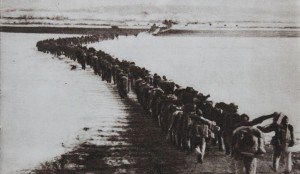
Chinese troops crossing the Amnok or Yalu River
Historically, Korea had been an independent kingdom closely linked to China’s imperial dynasties. Korea’s independence ended when Japan conquered the country in 1905. In 1945, defeated Japan surrendered Korea to the Soviet Red Army in the north and to the US army in the south with the 38th parallel being the arbitrary dividing line between the two forces. This temporary line quickly hardened into a permanent border as the USSR and the US supported the establishment of independent regimes in their respective Korean sections with governing systems which replicated their own political philosophies. The United Nations attempted to negotiate a compromise government that would allow the county’s reunification, but it was forced out in September 1948 by Kim Il-sung , the leader of the northern Democratic People’s Republic of Korea.
It wasn’t that Kim Il-sung was averse to reuniting Korea, it was just that he wanted to reunite it under communism and his control. On June 25, 1950, having secured both Stalin’s and Mao’s support, North Korean forces invaded the south. The United Nations, encouraged by the US, swiftly condemned the north as the aggressor. On September 15, 1950, a US-led coalition under the command of General McArthur and acting under the auspices of the United Nations launched a counter attack. By October 1st, the United Nations-Southern Korean Forces crossed the 38th parallel and pushed northward under a UN mandate to unite the whole country.
Mao watched the war unfold on the Korean peninsula with growing alarm. As the UN troops neared China’s border, he began to fear that China’s Manchurian industrial heartland was at risk of invasion. He also felt ideologically compelled to aid his Korean communist comrades, many of whom had fought alongside the CCP in Manchuria during the early days of the Civil War. He also wanted to reestablish China’s prominence on the international stage by supporting revolution in other countries. Stalin, too, was urging Mao to fight.

General Peng Dehuai signs armistice ending the Korean War
In October 1950, the PRC entered the Korean War calling it the “War to Resist America and Aid Korea”. On October 25, General Peng Dehuai led the first 400,000 of his troops into battle. The Chinese overcame the better armed UN forces by sheer numbers, and the United Nations troops were forced back behind the 38th parallel. General McArthur wanted to counterattack back into the north, but Truman refused. By July 1951, the United Nations initiated armistice negotiations. Given the huge communists losses, both the Koreans and Chinese came to the table. Negotiations faltered, however, over the return of Communist prisoners of war, many of whom pleaded not to be sent back to China. Only after Eisenhower took office and threatened to restart the conflict if the Communists did not agree, was an armistice agreement signed on July 27, 1953.
While Mao had fought the UN and the US to a standstill, its victory came at great cost to China. An estimated 700,000-900,000 Chinese were killed or wounded during the fighting – including Mao’s son Mao Anying – compared with 160,000 Americans, 400,000 South Koreans and 600,000 North Koreans. The US imposed a trade embargo on China and used its leverage to prevent the PRC from joining the United Nations. The US also moved closer to Taiwan and began to patrol the Taiwan Strait, and accelerated the conclusion of a peace treaty with Japan.
Despite these costs, however, China’s international prestige was greatly enhanced by the conclusion of the war. In his book On China Kissinger argues China overcame its comparative military weakness by using psychological domination as a weapon. Mao countered conventional wisdom by being willing to enter a new military conflict so soon after the country had emerged from decades of war. Publicly, he showed no weakness. Instead he showed indifference to the military strength of its rivals. This indifference extended to nuclear attack. Mao made the international community believe that China would be willing to endure hundreds of millions of casualties to defend the Chinese homeland and to promote communist revolution. In Korea, Mao played this strategy out. In the face a military superiority, Mao succeeded in overwhelming the enemy by sheer numbers. Mao was also demonstrating the Chinese aversion to encirclement. For Mao, it was worth 600,000 dead or injured in order to keep the enemy from his border.
Although it had to be paid for, the war also enabled China to obtain large amounts of Soviet ammunition and military equipment. The war also strengthened the Sino-Soviet alliance and increased the economic ties between the two countries. Sino-Soviet trade increased from approximately $300 million in 1950 to over $1 billion in 1952.
Domestically, the CCP used the war as evidence of the continued imperialist ambitions of the West and the persistent animosity of the United States for the Chinese people. This hatred and the heroism of the Chinese soldier became strong themes in CCP propaganda. It also used the Korean War as an opportunity it to further consolidate its domestic power.
The Hundred Flowers Campaign
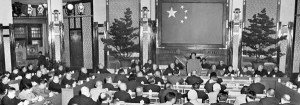
Mao Zedong announcing 100 Flowers Campaign
As the CCP tightened its hold over the country, many intellectuals became demoralized at their loss of intellectual, political and artistic freedom. Historically, most Chinese intellectuals came from wealthy families which had made or had inherited their money from landholding or business. In communist China such backgrounds were now considered feudal or reactionary. It became incumbent on these intellectuals to demonstrate their loyalty to the CCP by undergoing reeducation in revolutionary colleges and by writing confessions and self-criticism. Despite these challenges, the majority of Chinese intellectuals remained in China and many distinguished Chinese living overseas returned to China in late 1949 and 1950.
As China progressed through its first five year plan, many CCP members began to realize that its intellectuals were needed in order for China to continue to make social and economic progress. If these intellectuals were terrorized by the risk of punitive campaigns, their contributions to China would falter. Already, highly publicized attacks on intellectuals such as literary editor Feng Xuefeng in 1954 and writer Hu Feng in 1955 had made intellectuals wary. Many CCP members began arguing that the loyalty of intellectuals should be trusted even if they did occasionally criticize the party. Others in the party felt that unity was paramount, and that any criticism of the CCP would diminish its effectiveness and morale.
In 1956, Mao Zedong stepped into the debate by making two speeches in which he expressed the need for warm relations between party and non-party members. He said that the CCP should consider any reasonable views expressed by those outside the Communist Party. Specifically, he urged “letting a hundred flowers bloom” in the field of culture and “a hundred schools of thought contend” in the field of science. The idea was that greater intellectual freedom would help the government to fix problems and improve efficiency.

Zhou Enlai at Peking University 1957
Mao’s call was finally given full support by the CCP in May 1957. At CCP conferences, in the state-controlled press, at rallies on the streets and in posters pasted on university walls, intellectuals, students and the common masses began to speak out. They criticized policies such as the harshness of previous mass campaigns, censorship and the lack of political plurality. They criticized the many privileges enjoyed by party cadres and the many examples of their corruption. They complained about the lack of employment choices and about the harsh living conditions of China’s peasants. Industrial workers began to strike for better pay and working conditions. Key themes of the protests were that the Communist Party should relinquish its stranglehold on the government, that other political parties should be allowed to compete on an equal footing with the CCP, and that there should be a free press.
Startled and frightened by the vehemence of the criticism and anger, by June 1957, the CCP began taking steps to stop any further criticism. Mao Zedong altered the text of a key speech so that it now stated that intellectual freedom was only to be used to support the Communist Revolution and to strengthen socialism. Mao would later claim that his “hundred flowers” campaign had been a trick to flush out enemies of the revolution. By July 1957, the CCP propaganda machine was attacking critics in full force. Overall, an estimated 400,000 educated and professional men and women were labeled “rightist” which effectively destroyed their careers. Many were sent to labor camps, jailed or exiled to the countryside. Others committed suicide after breaking under the constant pressure of public struggle sessions. Others were shot.
The CCP used the Anti-Rightest campaign in a more broad base way to silence all forms of opposition and to re-impose Maoist orthodoxy in public expression. Having thus re-consolidated its authority, Mao and the CCP was ready to lead China into the next level of socialism.

